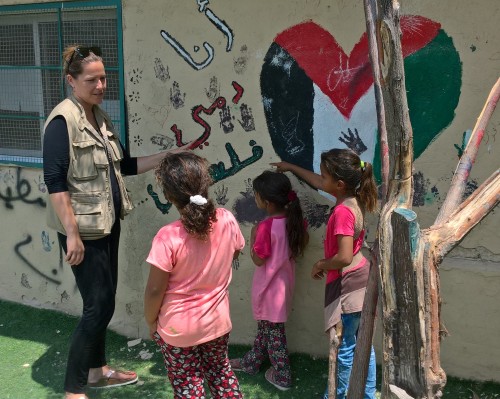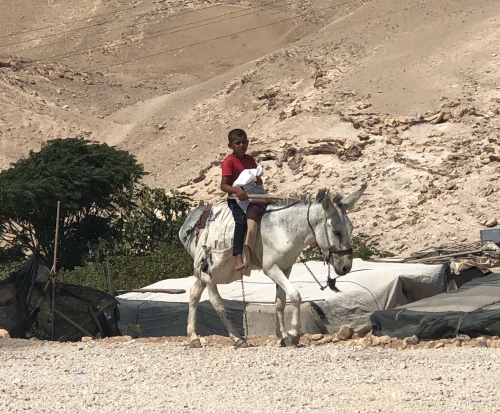“Oh my God! What is this for?!” We are driving through the West Bank when Mohammed*, our Palestinian colleague, sees a yellow digger on the back of a lorry and becomes concerned. It is parked next to an Israeli army watchtower, which are dotted all over the occupied Palestinian territory and are ugly reminders of the military occupation, now into its 52nd year. Army jeeps approach the lorry and it forms a convoy which moves off.
Mohammed is upset because this is the kind of equipment used by the Israeli authorities to demolish the homes of some Palestinians.

Diggers like this one we saw can be part of the equipment used by the Israeli authorities for demolitions of Palestinian homes and other property
I am back in Palestine and Israel, 5 years after my stint working with EAPPI as a Human Rights Observer in Hebron. This time I have donned my EAPPI jacked for just a week, and am providing protective presence cover in Yanoun in the West Bank, one of the smallest surviving Palestinian villages. Yanoun is under threat because the Israeli settlements (illegal under international law) and outposts (illegal under both international and Israeli law) on surrounding hilltops want to take the village’s land, and have used violence to try to bring this about.
On this occasion, we are on our way to Khan al-Ahmar, a Bedouin village east of Jerusalem in an area known as E1. This Bedouin community has lived in this area since the 1950’s yet Khan al-Ahmar is due to be destroyed by the Israeli authorities in the next few days. The nearby Israeli settlement of Kfar Adumim wishes to expand. And so the Israeli Government is set to bulldoze the homes of 173 Bedouin people, including 92 children. This includes a school funded by the international community, which educates over 150 children.

Some of the girls who live in Khan al-Ahmar showing me round their school. The school is known as the ‘Tyre School’ because it was built of tyres and sand in a bid to comply with Israeli regulations forbidding the use of concrete. It is funded by the international community.
Abu Khamis is the leader of the Khan al-Ahmar community. His anxiety is palpable – he tells us, “There is not much time. I hope we can stay here.”
Despite the enormous stress that the community is under, we are welcomed with typical warm Palestinian hospitality. Men and children are sitting on cushions in a shady area. Mattresses and blankets are piled up for the other international visitors who sometimes sleep in the community to help the residents feel safer through their protective presence. We are given coffee, pitta bread, falafel and grape juice. Later, we sit with the women, who give us orange juice and offer tea and yet more food. The international support matters to people here – a resident called Ibrahim tells me, “We know we are not alone and this makes us feel strong.” But there is frustration that multiple statements of support for Khan al-Ahmar from European and other governments have had no impact on the Israeli Government’s plans for demolition.

Abu Khamis, leader of the Khan al-Ahmar community, “There is not much time. I hope we can stay here.”
For most of us, it is virtually impossible to imagine the government sending bulldozers to destroy our home. But sadly, house demolitions are not a rare phenomenon for Palestinians living in Area C in the West Bank, which has been occupied by Israel since 1967. According to the UN, between 1988-2016, 3344 Palestinian homes or other structures were demolished, with a further 12,741 having a demolition order against them.
In Khan al-Ahmar, the residents have been fighting the threatened destruction of their community for years, including in the Israeli courts. The Israeli authorities say that the village structures were erected without the necessary permits, despite the fact that they are almost impossible to attain – according to Israeli human rights organisation Bt’Selem, almost 99% are not approved. Now we are likely in the final days before the bulldozers come. The demolition order is ready. A few days ago, the Israeli authorities installed military gates at the community entrance and flattened the road to give the bulldozers easier access.

Military gates including this one have now been installed by the Israeli authories at the entrance to Khan al-Ahmar to make the demolition easier
The only delay is whilst there are discussions about where the residents may be relocated to. Current propositions from the Israeli authorities include the vicinity of a rubbish dump, and of sewage pipes from Israeli settlements. Aside from whether these would be fit for human habitation, they do not include the space needed for the community’s sheep to graze. Keeping animals is an essential part of the Bedouin way of life, and of earning a living.

A boy on his donkey in Khal al-Ahmar
People in the village are exhausted and frightened. Hussein, who lives here, told me, “We are tired of being scared that bulldozers will come… We will not leave by choice, only if they force us.”
In response to what is happening in Khan al-Ahmar, British MPs like Wes Streeting have called for targeted economic sanctions on Israeli settlements – on 4 July 2018 in the House of Commons he said, “if Israel is going to demolish Palestinian villages on the grounds that they are illegal settlements, is it not time for this country and our European partners to take targeted economic sanctions against illegal Israeli settlements in the West Bank?” Many believe that part of the problem is the international community’s failure to back up their concerned press releases over these kinds of Israeli Government abuses of Palestinian human rights with actual consequences. In July, the Irish senate voted in favour of a bill banning the importation of products from Israeli settlements. And on 7 August 2018, some British Conservative and Labour MPs jointly wrote to British Prime Minister Theresa May about Khan al-Ahmar, stating, “It is clear from the actions of the Israeli Government that the time has passed when releasing British Government statements of concern will have any impact on proceedings. We believe that the planned destruction of Khan al-Ahmar represents a test by the Israeli Government as to the international community’s willingness to take meaningful action in response. Until there is a significant price to be paid, it seems clear that such abhorrent acts will proceed.” They asked her to urgently raise the situation of Khan al-Ahmar with Israeli Prime Minister Benjamin Netanyahu.
The forcible transfer of a population in this situation is contrary to International Humanitarian Law, and is recognised by the International Criminal Court as a crime against humanity. Bt’Selem says, “This constitutes a war crime for which all those involved bear personal liability.”

A Bedouin woman in Khan al-Ahmar looks out towards the illegal Israeli settlement of Kfar Adumim on the hilltop in the distance, which is set to expand if her village is destroyed
If the destruction of Khan al-Ahmar goes ahead then it is likely that other nearby Bedouin villages with demolition orders against them will be next. The location of the village in the E1 area is highly significant – Israeli settlement expansion in its place could pave the way for the West Bank to be split in two. This would destroy the possibility of a contiguous Palestinian state and, most likely with it, any remaining hopes of a two state solution to the long and bloody conflict between Israel and the Palestinians. Abu Khamis says, “People from Palestine are losing belief in peace.” It’s not hard to see why.
Abu Nimr, another visitor to the village who is Palestinian tells me, “The Bedouin will refuse to leave. But in the end, we know they [the Israeli army] may use force.” This is a place whose days seem to be numbered; and whose people do not know their fate.
If they destroy Khan al-Ahmar then, as well as destroying innocent people’s homes, the Israeli Government will be bulldozing the prospects for peace.
*name has been changed for privacy
